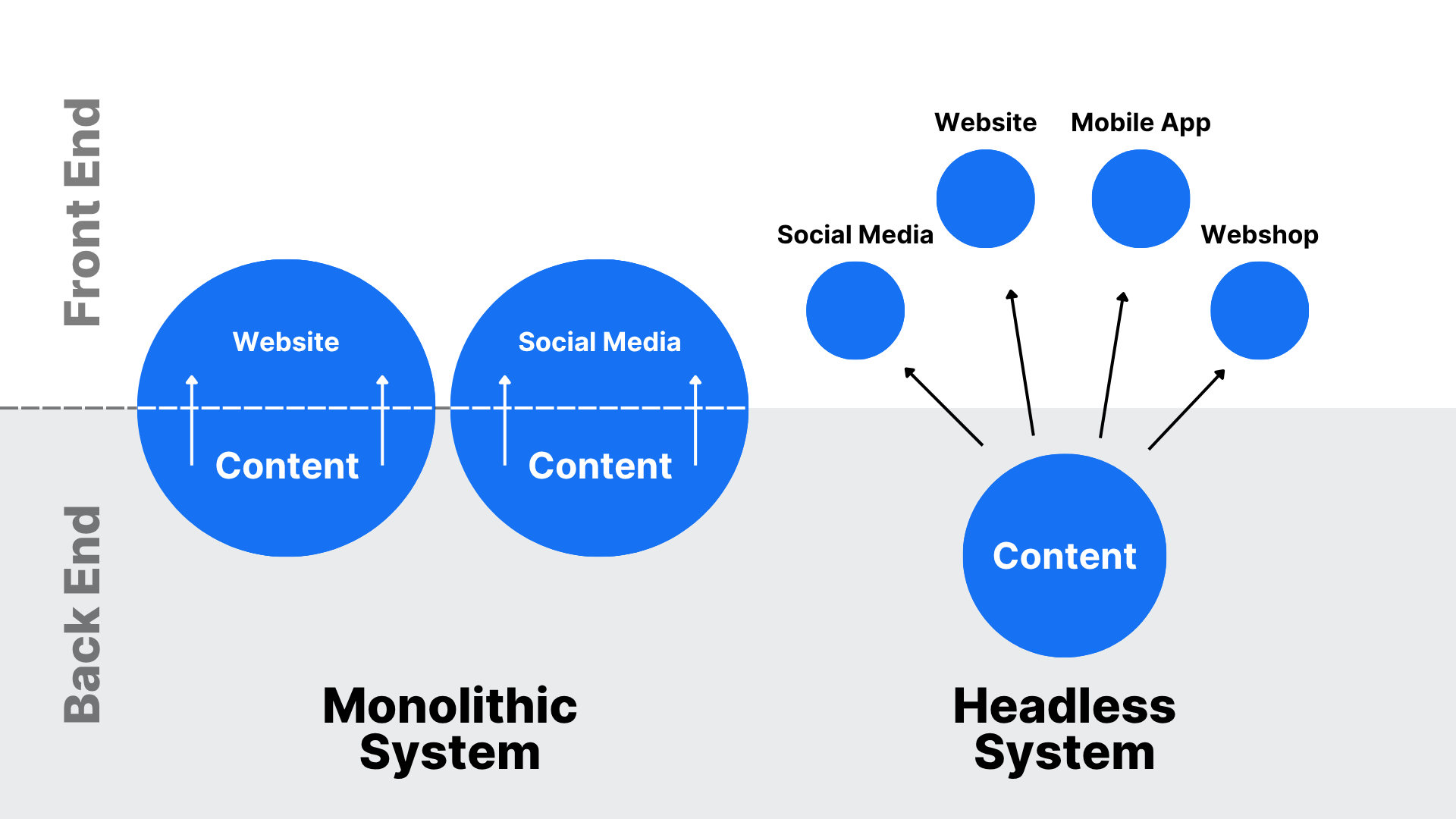Headless Commerce is a modern approach in which the front-end of a webshop (the user interface) is fully decoupled from the back-end (the engine handling product management, inventory, payment processing, and order fulfillment). This approach is built on the principles of MACH architecture, a future-proof strategy that prioritizes flexibility, personalization, and autonomy.
The separation is made possible through APIs (Application Programming Interfaces), giving you greater freedom to design customer-centric digital experiences.
In a traditional e-commerce environment, such as an All-In-One platform, the front end and back end are tightly connected. In Headless Commerce, these layers are intentionally separated. The front end communicates with various back-end systems via APIs.
This separation allows developers to use different technologies to build front-end experiences, without being limited by the constraints of a single platform.
 A Monolithic System vs. a Headless System: Content can be distributed from a single central source.
A Monolithic System vs. a Headless System: Content can be distributed from a single central source.
Headless Commerce is ideal for organizations seeking flexibility, rapid innovation, and a personalized customer experience across multiple channels. Companies focused on growth, global expansion, or delivering a seamless omnichannel strategy can benefit greatly from adopting a headless approach.
Flexibility in design and functionality: Because the front end is decoupled from the back end, businesses can make fast changes without being limited by the constraints of a traditional e-commerce platform.
Rapid response to market changes: Thanks to its modular structure, new technologies can be easily integrated without disrupting existing systems or customer experiences.
Omnichannel capabilities: Content and e-commerce functionality can be effortlessly shared across multiple channels, including websites, mobile apps, and social media.
Performance and scalability: A decoupled architecture enables front-end and back-end systems to be optimized and scaled independently. This leads to better performance and a smoother user experience.
More control over your tech stack: Headless Commerce lets you choose services that best fit your specific needs, and select the most suitable vendor for each one (best-of-breed).
The best solution depends on your organization’s needs. For some businesses, an all-in-one platform is ideal due to its simplicity and integrated approach. For others, it can feel too limiting, and a headless solution offers more room to grow.
That’s why it’s important to assess where your organization currently stands and what your future plans are, so you can choose a platform that aligns with your long-term ambitions.
The key difference between an All-In-One platform and Headless Commerce lies in how the front end and back end work together. In an all-in-one setup, the user interface (front end) and the management system (back end) are tightly integrated into a single system. This makes it easy to use but can limit innovation and customization, as you’re restricted by the platform’s built-in capabilities.
With Headless Commerce, it’s the opposite: the front end and back end are decoupled. The back end delivers data via APIs to multiple front ends, such as webshops, mobile apps, or other digital touchpoints. This gives businesses maximum flexibility to tailor their digital experiences and roll out new features faster.
Headless Commerce is part of Composable Commerce, but they’re not the same. Headless focuses mainly on decoupling the front end from the back end, while Composable Commerce goes a step further by making your entire system modular, using only the tools and services you truly need.
With Composable Commerce, you build a complete e-commerce ecosystem using multiple specialized components (best-of-breed solutions) that communicate with each other via APIs.
Curious if this approach is right for your business? Read more here or get in touch we’d be happy to help.
Every organization is different, and the choice between Headless Commerce, All-in-One, or Composable Commerce depends on your specific needs and goals. Still unsure or curious how this would work in your situation?
Let’s think it through together! A reliable partner helps you make the right decisions and find a solution that perfectly aligns with your ambitions. Get in touch and discover how we can help take your e-commerce to the next level.
Four steps to take into consideration before you make the switch.
Continue readingWhat to expect from your Composable Commerce trajectory.
Continue readingWant to stay informed about everything happening with Composable Commerce? Sign up for our updates here!
We've built converting e-commerce platforms for our customers for more than 15 years.
You don't just pick a new e-commerce platform. Especially with the sheer volume of available vendors and services. What's the best course of action? Together we will determinate the technical solution that best fits your business goals. Do you want to know how we approach e-commerce projects? We'd love to start a conversation!
Get the right insights!E-Commerce Solutions Specialist
Digital Experience Expert